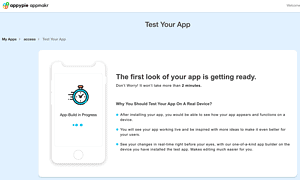If you want to reach people where they’re at, then you might be looking into how to turn your membership site into an app.
After all, more people are turning to online learning now than ever before, and having your content available through a native iOS or Android app could make a huge difference for your students and clients. Just like with community platforms, an app can create a sense of belonging and engagement, allowing your members to connect and interact seamlessly while on the go.
In this guide, we’re going to look at why you should consider creating an app for your membership site or online courses, what you need to know before you get started, and some recommended tools and services to build your app.
Let’s dive in!
What is a membership app?
A membership app can elevate your digital product or online learning course to new heights. Creating a branded membership app can be a powerful way to establish a stronger membership community, enhance engagement, and create a more personalized learning experience for your membership site students.
Why you should consider building an app for your membership or online courses
With over 3.5 billion smartphone users across the world and another 1.4 tablet users, there’s no doubt in anyone’s mind that mobile app platforms are growing.
All of these mobile app users have plenty of choices when it comes to the apps they download: the Apple App Store has 2.2 million apps, and the Google Play Store offers 2.8 million apps to download.
But the real reason it’s worth considering going the app route is if your existing clients are asking you to create one.
Creating an app first, without having a minimum viable product that has sold to a small group of real customers can be a dangerous path to take.
That’s why it’s better to let your members lead the way, and once you’ve got your app in the various directories you might be able to gain new clients from the added exposure and user engagement.
Now let’s take a closer look at all of the benefits of having an app for your online courses or membership site.
1. Apps provide more value for your members
Having an app does more than just add an extra selling point on your membership sales page.
It can also provide a new reason for your existing members to stay on longer, fostering a stronger sense of community within your membership over time. And it can even lead to a more profitable membership business, since you can charge more for different membership levels with unique membership offerings, levels of access, and resources, like gated video content, content updates, etc.
Sometimes with recurring membership sites, things can feel stale, and announcing an app addition can bring renewed interest and engagement for your current customers and overall improvement of your membership plans.
The value of your app will depend on how much your members take advantage of it, so it’s important to think about how you can make it easy to use when you’re designing your app.
2. Apps increase member retention and content consumption
If your members and students tend to login once and then disappear, being able to reach them on their devices might be a way to help them consume more of your courses and experience your exclusive content.
Different people use technology differently, and depending on your teaching topic you might find that people love to “snack” on your courses while waiting in line or while taking a walk.
Dedicated online membership platforms offer a seamless way to manage access to various membership tiers, ensuring that each tier receives the appropriate content and benefits. This dynamic approach allows you to create a personalized experience for each member based on their membership tier, enhancing their satisfaction and engagement.
This added touchpoint is only possible because an app helps give you more brand presence.
3. Apps increase brand presence
When you look at your phone or tablet, what you see matters. If there’s no mention of that paid membership or online course you signed up for, you’re more likely to click the Netflix icon or head over to CandyCrush.
By having an app for your business, you’re staking a claim and showing up on the mobile dashboard. That means your clients are more likely to click through, and even if they don’t, they will at least remember that they signed up for your work.
This added brand presence is especially important in today’s noisy and distracting world.
Another aspect of brand presence is when your app shows up in the Apple or Android app stores when people are searching for your keywords. That could be a whole new way of getting potential customers into your online courses and membership model.
4. Apps offer push notifications
Apps offer push notifications, one of the core features that can increase membership engagement. These push notifications can serve as a powerful tool to communicate with your members and keep them informed about upcoming events, new content releases, and special membership perks.
By sending timely reminders and updates directly to your members’ mobile devices, you can ensure that they stay engaged and active within your membership community.
Speaking of distractions: there’s a way to use push notifications inside your business app to remind the vast majority of users about their membership and courses.
Not all apps will come with notifications built-in, but if you know that the type of content and client that you’re connecting with could benefit from reminders and notifications then it’s worth setting them up.
Email reminders work great, but people can unsubscribe or the emails may land in the spam folder. That’s why an app’s push notifications could be a good back up plan.
5. Apps meet learners where they’re at
Not everyone has time to sit down at their desk to go through an online course or listen to a membership recording.
That’s why having a mobile app can offer the added benefit of meeting your customers where they’re at and helping them learn on the go.
If you’re in someone’s pocket, they’re more likely to be able to take advantage of your membership than if they need to be in front of a desktop.
6. Apps offer social benefits
If you decide to build an app that has social aspects built-in, then another benefit for your customers will be that they can connect with their peers through your business app.
Not all apps come with this type of social media functionality built-in, so consider if it’s something you really need before choosing which route to go when getting your app designed and built.
If you’re still not sure if it’s worth pursuing the “membership site to app process”, then some examples of successful conversions can help you see for yourself.


3 Things you should have in place before you attempt to build an app
If you’ve decided to explore building out your own app further, you’ll find that the entire process is much easier if you already have a few things out of the way.
1. Make sure your website is mobile-friendly
The most important thing will be to ensure that your existing membership site or course portal is mobile-friendly.
That is usually done through a mobile-friendly theme on WordPress, or if you’re running a custom-coded site then you’ll want your developer to pay special attention to the mobile readiness of your site.
There are specific themes that can turn your existing site into a mobile version, and some that work directly with app conversion services to make it even easier to go from membership site to app. Learn more about popular WordPress LMS themes, and Elementor membership sites.
2. Get a payment processor that works on mobile apps
Whether you plan to sell your app directly through the app store of your choice, or you want to take payments on your own website first, you’ll need a way to take payments for additional gated content.
One of the tricky aspects of running a paid membership site or selling online courses that have an app attached is that you’ll want to be able to sell within your app, for those who find your app first.
An example from a fitness video training app worked like this: you could purchase a paid subscription on the website and then download the app, or download the app for free and then pay within the app for access to the premium content you create.
Either way, you’ll want to be able to take and manage recurring subscription payments or one-time sales.
3. Your course or membership content organized into digestible bite-sized formats
The upside of learning on the go is that your clients have access to your content all the time. The downside is they may not have time to watch an hour-long video while they’re out and about.
Instead, you’ll want to break down large training materials into smaller bite-sized multimedia content. For example, you might have 10 five-minute videos that can be watched as time allows, or that come with transcripts for easier absorption.
Doing the work of “chunking down” your long-form content mix into smaller pieces is going to help all of your learners, not just your mobile app customers. If you’re looking to get inspired, check out other membership site designs.
How much you can expect to pay for your app
You might be wondering how much it will cost to build an app for your course or membership site.
The answer is that it depends on what route you take, and whether you want to do it yourself, hire an agency, or go for a hybrid service that does some customization but keeps most of your site as-is.
Either way, you will need to purchase your own Apple and Android developer accounts, for $99/year and $25 respectively.
This gives you the ability to upload your app to both app stores, and keep them up to date and within your own control.
Some done-for-you app services may cover these fees for you, but I would recommend you set up your own accounts if you can so that you won’t be at the mercy of the people you hire if something needs to be changed down the line.
Let’s take a look at some of the cost break downs for building an app, with some concrete examples:
- AppPresser starts at $79/month up to $149/month depending on what key features you need and how many people are using your app. Plus a $199 set up fee if you go with the monthly plan.
- GoNative is $790 license, with add-on modules that range from $200 to over $5000.
- App Match starts at $129/month with a $199 set up fee.
- AppyPie starts at $15/month all the way to $50/month.
All in all, I would recommend setting aside at least $1500 for the first year to cover the setup costs of your app but consider a higher budget if you plan to go with more feature-rich or customizable options.
The possible hurdles and downsides of having an app
We’ve looked at why your business might benefit from having a mobile app, how much it might cost to get an app up and running, and now we’re going to look at some of the hurdles you might encounter.
1. Added complexity
Let’s face it: if you’re not an app developer, creating an app will add some additional complexity to your business. It doesn’t mean it’s not worth it, but the more moving pieces in your tech stack, the more there is to understand and manage.
2. Lack of integration with existing systems
One of the tricky parts of running an online course or membership site is that your content is usually behind a passworded area.
What happens when you add an app that doesn’t hook into your existing membership? Do your members need two different passwords, or is there an integration that makes it seamless for them to be logged in on one device and then on another?
These are the types of things that lead to increased complexity, ensuring that your app becomes an integral part of your members’ experience, making their membership package even more appealing and useful.
3. Price and additional costs
We’ve already looked at how much it can cost to build a mobile app for your training business. You’ll need to factor in these added costs to see if they make sense in the grand scheme of your business income and expenses.
You might also want to plan for further development costs down the line if things change and you need to upgrade or re-do your app for a new mobile platform that might come on the scene.
4. Increased maintenance as things change
One thing that all eager entrepreneurs focus on is the results we’re trying to achieve. The downside is that we sometimes gloss over the long term repercussions of our decisions, and that includes maintenance of our decisions. (I’m just as guilty of this myself!)
For example, let’s say you release a simple mobile app for your membership site and you realize that you want to add push notifications. That’s an additional add-on and takes more time to set up and maintain separately from your other forms of communication.
Or you might realize that one aspect of your app isn’t working and needs to be removed. If you’re in control you can make those changes, but depending on how you went about creating your mobile app you may need to hire someone else to make these changes.
5. Getting your app approved for the Apple and Android app directories
Believe it or not, you can’t just make an app have it appear in the Apple and Android directories without having it reviewed and approved first.
That means you might be missing out on some brand presence if you don’t follow their guidelines to the letter.
6. If selling through your app, then you’re sharing a percentage with the app store
Depending on how you structure your app’s business model, you may end up sharing between 15% to 30% of your recurring or one-time revenue with the Apple or Android app stores.
That may be a negligible amount if you’re getting more clients through these app directories to offset the costs of delivery. However, it is a high price to pay if you’re generating your own sales already.
7. Maintaining 2 different apps for Android and Apple operating systems
Another downside of getting into the app business is that you need to offer two different versions to accommodate the market.
Most people use an Android or Apple mobile device, and if you only offer one you’ll get endless requests to release your app for the other operating system.
With two apps to manage and maintain, that means keeping up with more tech systems and ties back into the complexity piece.
8. Additional tech support
You might think that everyone knows how to use apps, but by offering another way for people to access your content you’ll be opening yourself up to more support inquiries.
Whether a download link doesn’t work, or someone’s version of their iOS or Android OS is not compatible with your app, you’ll be hearing about it.
This may not be a dealbreaker because every business has customer support, but it’s something to consider before you take the plunge.
How to convert your membership site into an app for iOS and Android platforms
Still reading? Great, that means you’re still considering creating an app for your membership site or online courses.
Now we’re going to look at how to do it, and the 4 most common approaches to building an app based on an existing members-only area.
Option 1. Do it yourself with a website converter
If you want a way to test your app and make sure that people will actually use it, then using a website converter option is great.
There are a few places that will let you create a free app based on your existing website and that can give you a feel for what’s possible.
You’ll need to pay to have your app work for the Apple and Android directories, but by then you’ll at least know if the app is a viable solution for your goals.
Despite the fact that you’re doing it yourself, this approach isn’t as hard as it sounds. Yes, there will be a learning curve, but because website converters don’t typically offer a lot of bells and whistles it tends to be a process that’s limited in scope by design.
Option 2. Choose a service that includes an app
If an app is an absolute must, you might even consider building your membership or course website on a platform that has a built-in app.
If you’re willing to lose out on the branding aspects of having your own dedicated app, platforms like MightyNetworks and Kajabi offer an in-between solution.
How it works is that both platforms have an app in the Apple and Android app stores that your customers download. It will say MightyNetworks or Kajabi, but from there they can log in and see the courses or memberships that they purchase from you.
You could also invest in the highest tier with MightyNetworks Pro, which comes with a heftier multiple thousand dollar price tag, to get your own semi-customized branded app.
If you want to go this route, read our MightyNetworks and Kajabi comparison.
Option 3. Work with a website converter service or agency
This is a nice in-between option for building an app because it gives you more functionality and customization, without having to pay for building an app from the ground up. These services can also integrate seamlessly with your existing email marketing campaigns, allowing you to reach your members through multiple channels.
Usually, a website conversion service will mean that your existing membership site or online course site will be turned into an app, with a few add-ons like push notifications or other things to improve mobile navigation.
This type of service will also typically submit your app for your to the directories and help you get everything approved and up and running.
Plus, it’s nice to know you’re working with someone who has done this before and if you run into any questions they can help!
You’ll see our recommendations for these app creators in the next section.
Option 4. Hire a development team for a fully custom app
Finally, if an app is a huge part of your business model then you might want to hire a team of app developers who can build something from scratch for you.
This tends to be the most expensive way to go and might come with bigger risks because once it’s done you may need to keep this team on retainer to make changes or find someone else who can maintain your app going forward.
For most businesses, it doesn’t make sense to hire a team of developers to create an app from scratch. There are so many other great options, so let’s look at them below!
Our Mobile App Development Recommendations
This is where theory becomes reality, and it all starts with real mobile app services and development recommendations.
AppyPie: do it yourself option for any website
AppyPie is one of the first results you’ll find when you do a search for how to turn a website into an app. It’s straightforward, and you can have a testable version of your website app up and running within 10 minutes.
It’s a pretty good option, it won’t break the bank, and it really turns your website into an app. So you’ll want to make sure that your website is very mobile-friendly.
GoNative: do it yourself option for any website
Another option is GoNative, which is a popular tool to turn any website into a mobile app. It’s straightforward, and although you won’t have a testable app as quickly as with AppyPie, GoNative does offer a different set of customizable options.
It’s also going to turn your website into an app directly, so again you’ll want to make sure your site is mobile-friendly from the get-go.
AppPresser: do it yourself WordPress solution
If you have a WordPress site or WordPress membership site, then AppPresser is an especially enticing option. It will turn your existing site into an app, but instead of just wrapping a webpage into an app, it does some additional work under the hood to make it more of an app experience.
AppPresser does that through a WordPress theme that they provide you when you sign up. That means your membership site will have two different looks: one for desktop and mobile, and one for your app.
This could be a downside of using AppPresser, but it does help ensure that your app is approved through the app stores, so it’s very much worth considering this option.
The App Match: do it yourself option
Another great do it yourself option that is done through a software platform is The App Match. It’s a great option because it’s very feature-rich and doesn’t charge for additional add-ons along the way.
The app builder gives you a lot of flexibility and it is designed for memberships and online course creators, including private podcasts.
It ticks a lot of the checklist items that AccessAlly clients are looking for, and we have several happy mutual clients who use App Match with AccessAlly.
Membrandt: CRM-focused software platform option
If your focus is really on the CRM automation side of things, then Membrandt might be another software platform option to look into. It was originally designed to work with Keap/Infusionsoft, and now integrates with several other CRMs.
This is a service that will do the setup work of your app for you, and where you’ll be able to maintain your app after the fact.
App Boss: hire a development team
If you’ve got a hefty budget and you want to go all out with your app, then a dedicated app development team like App Boss might be a good place to start your search.
Projects start in the multiple thousand range and will depend on what you’re trying to accomplish and how custom or advanced you want things to be.
Final Thoughts
Don’t let all these considerations bog you down.
If creating an app is the next step in your online business evolution, you’ve hopefully got all of the information you need to take the plunge!






